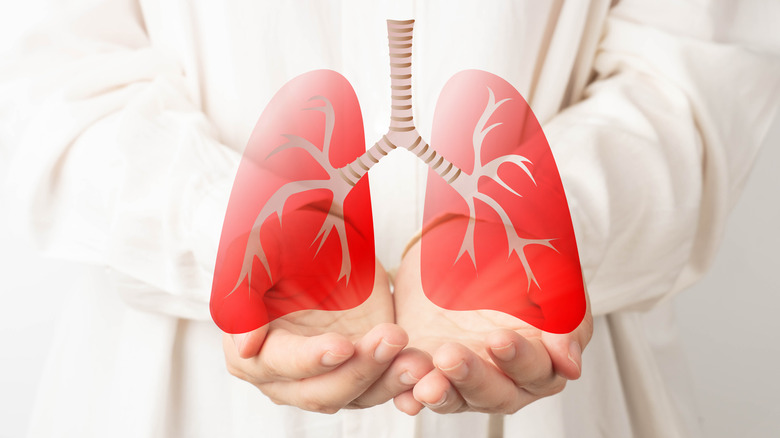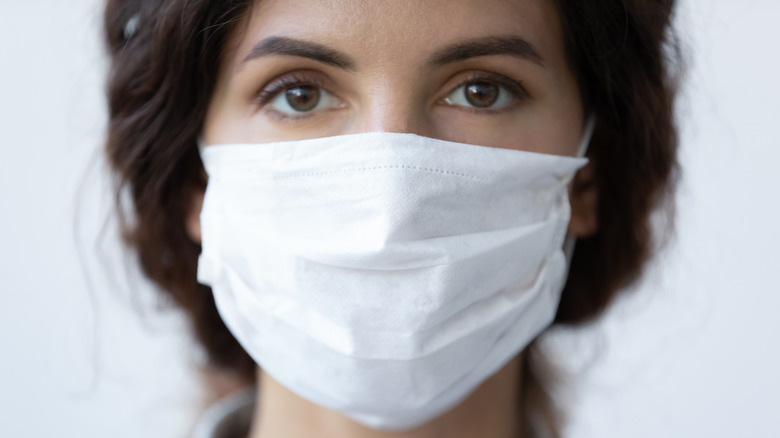Myths You Should Stop Believing About Tuberculosis
Tuberculosis (TB) is an infection that usually involves the lungs, although it can sometimes be found in other organs like the brain or kidneys, says Johns Hopkins Medicine. It is usually caused by the Mycobacterium tuberculosis bacterium.
A person with an active infection will exhibit symptoms such as chronic cough, chest pain, coughing up blood, fatigue, night sweats, chills, fever, loss of appetite, and weight loss, according to WebMD. You may be more likely to contract TB if you know someone who has it, have traveled to a location where it is common, belong to a group that is more likely to spread the illness, work with people at high risk of the disease, or are a smoker.
The U.S. Centers for Disease Control and Prevention (CDC) explains that TB can be easily tested for by receiving an injection of a small amount of fluid called tuberculin under the skin. After being given the test, you must return within two to three days to have the area inspected by a trained health care professional. If the area becomes raised, hard, or swollen during this time period, then depending on the size, you may be positive for the disease. Alternatively, a blood test could be used.
One important way to combat TB is by making sure that you educate yourself about some of the more common myths that surround it.
Myth 1: People with TB are always infectious
Many people with an infection never go on to develop the active disease and will have latent infections that are kept in check by their immune systems, says Johns Hopkins Medicine. In these cases, they might test positive on a TB skin test, but have normal-looking lungs in their chest X-rays.
If a person's immune system is unable to stave off the disease, however, they may develop an active infection. This would be evidenced by a positive skin test as well as a positive chest X-ray. People with weakened immune systems are especially prone to developing active TB infections.
This distinction between latent and active disease is important because it is people with active infections who are capable of transmitting the disease to other people. Medical News Today explains that, in order for the disease to be contagious, the bacteria must also be present in the throat or lungs. If it's in other organs, it is highly unlikely that you will spread it to other people. They add that TB typically stops being infectious after about two or three weeks of treatment.
Myth 2: TB can be genetically inherited
We now know that TB is mainly caused by the aerosol transmission of the bacterium Mycobacterium tuberculosis. However, it used to be that people didn't really understand what caused it or how to prevent it. In fact, many people believed that it could be passed down genetically. This was probably because people living in the same household often had the disease, says Medical News Today.
That being said, however, research reported in the National Library of Medicine indicates that your genes might influence your individual response to the bacterium. Some people appear to have genes that make them more resistant to infections. Others seem to have more severe disease in childhood, perhaps due to single-gene inborn errors of interferon-γ immunity. A 2019 report published in Oxidative Medicine and Cellular Longevity indicates that research into this area is ongoing, but might eventually form the basis for the prevention or treatment of TB.
Myth 3: Only certain groups of people can get TB
TBa!ert writes that TB is often a stigmatized illness, especially in certain cultures. It can be thought of as a "curse" or related to witchcraft, they explain, so people may be shunned by their communities or have a difficult time getting married because of it. Unfortunately, these misunderstandings can cause people to avoid seeking the diagnosis and treatment that they need.
Additionally, infection with TB is often associated with conditions like poverty, alcohol and drug misuse, HIV, refugee status, homelessness, and imprisonment, they write. These factors themselves can cause people to cast blame or stigmatize others, amplifying the problem. The truth is, while some people might be at greater risk for contracting it, anyone can get it, even if they don't belong to a high-risk group. All it takes is being exposed under the right conditions. TB doesn't care who you are.
While many people believe that TB only affects people in certain countries, Medical News Today points out that although 44% of new TB cases are detected in South East Asia, nearly 9,000 cases of TB were reported in the U.S. in 2019.
Myth 4: TB can be spread through casual contact
According to TBFacts.org, you can catch TB in one very specific way: breathing in the air that someone who has an active infection has breathed out. When a person has the disease, the bacteria that cause it are carried in droplets that are released into the air when they speak, sing, sneeze, or cough.
This means that it is not transmissible by touching someone or touching things that they have touched, nor can you catch it by kissing someone or sharing a toothbrush with them. It is also not transmitted by water or food, notes the CDC.
Johns Hopkins Medicine states that good ventilation is an important step in preventing the transmission of TB. The CDC suggests that patients wear a surgical mask to catch any airborne droplets. They further recommend that health care workers should wear a filtering facepiece respirator so they don't inhale the droplets.
The CDC adds that people with active TB in their lungs or throat should stay home from school or work and avoid meeting up with friends until a doctor determines that they are no longer infectious.
Myth 5: TB is a death sentence
While it is true that TB can kill if it's left untreated, this disease is very treatable with medication, says Medical News Today. They point to the antibiotic isoniazid as being the most common drug used to treat latent TB. Treatment involves taking the drug for around six to nine months.
When people have active infections, however, it may be necessary to give a combination of medications for up to a year. The drug isoniazid is often used along with rifampin, ethambutol, and pyrazinamide as first-line treatments for tackling TB infections.
Altogether, there are ten drugs which have been approved by the U.S. Food and Drug Administration for the purpose of treating TB, according to information from the CDC.
The CDC does report, however, that drug-resistant TB exists. In these cases, treatment is complicated and must be managed by an expert in the disease.






